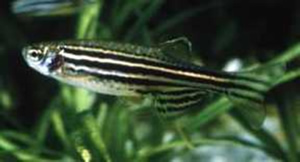 ゼブラフィッシュは、胚が透明で発生過程で働く遺伝子を容易に見いだすことができるため、優れた実験動物として発展してきています。しかしながら、この魚ではマウスのES細胞で行われているような、細胞培養系を用いた遺伝子改変技術や相同組換えによる逆遺伝学技術は確立されていません。魚類の生殖細胞の成立には母性因子を必要とすることから、私たちは魚類では生殖細胞にも体細胞にも分化する万能性幹細胞の培養は難しいと考えています。そこで小型魚類開発研究室では、遺伝情報を次世代まで伝える細胞として生殖細胞に着目して、生殖細胞をベースとした遺伝子改変技術の確立を進めています。これまでに、精原細胞を機能的精子まで分化させる培養系と精原幹細胞培養系を確立し、ウイルスベクターでこれらの細胞に遺伝子導入できることを確認しています。さらに、兄妹交配を20世代以上にわたり繰り返して、相同組換えに有利な均質なゲノムを持つ近交系を樹立しました。現在、これらの技術やリソースをもとに、ゼブラフィッシュにおける相同組換えによる逆遺伝学的手法の確立を進めています。
ゼブラフィッシュは、胚が透明で発生過程で働く遺伝子を容易に見いだすことができるため、優れた実験動物として発展してきています。しかしながら、この魚ではマウスのES細胞で行われているような、細胞培養系を用いた遺伝子改変技術や相同組換えによる逆遺伝学技術は確立されていません。魚類の生殖細胞の成立には母性因子を必要とすることから、私たちは魚類では生殖細胞にも体細胞にも分化する万能性幹細胞の培養は難しいと考えています。そこで小型魚類開発研究室では、遺伝情報を次世代まで伝える細胞として生殖細胞に着目して、生殖細胞をベースとした遺伝子改変技術の確立を進めています。これまでに、精原細胞を機能的精子まで分化させる培養系と精原幹細胞培養系を確立し、ウイルスベクターでこれらの細胞に遺伝子導入できることを確認しています。さらに、兄妹交配を20世代以上にわたり繰り返して、相同組換えに有利な均質なゲノムを持つ近交系を樹立しました。現在、これらの技術やリソースをもとに、ゼブラフィッシュにおける相同組換えによる逆遺伝学的手法の確立を進めています。
一方で、上記の雄生殖細胞培養系は精子形成の制御機構の解析にも優れています。すでに精子形成が異常となる突然変異体を複数単離できており、in vitro培養系を組み合わせて、脊椎動物に普遍的な精子形成制御因子の研究を併行して進めています。
Zebrafish have become a laboratory favorite because their embryos are transparent: geneticists can easily observe gene effects in the developing fish. However, cell-mediated gene transfer methods such as mouse gene replacement using embryonic stem (ES) cells, which facilitates the knock-out and knock-in of targeted genes, has not yet been developed in zebrafish. Since the formation of zebrafish germ cells appears to harbor determinants that are provided maternally, it may be difficult to establish a pluripotent stem cell line that can differentiate into both somatic cells and germ cells in zebrafish. Thus, we focused on germ cells since the genetic information is transmitted in the germ-line, and are developing techniques on germ cell-mediated gene transfer in zebrafish. We have already established methods to make genetically modified zebrafish using sperm cells grown in vitro and to culture spermatogonial stem cells recently. Furthermore, we have also established an inbred strain by consecutive sib-pair mating for more than 20 generations. Individual fish in the strain are nearly identical to each other in genotype. We are currently working to establish reliable protocols to lead to specific genetic changes by homologous recombination in the germ cell.
In addition, these male germ cell culture systems should prove useful not only in cell- mediated gene transfer methods, but also in analyzing the spermatogenesis. Using spermatogenic mutants recently identified in zebrafish and in vitro culture systems to advantage, we are also investigating the molecular mechanisms to regulate mitosis and meiosis in the male germ cells of vertebrates.